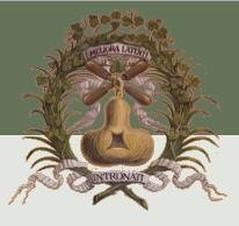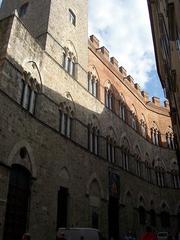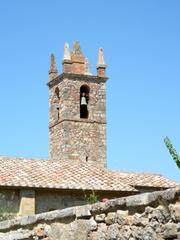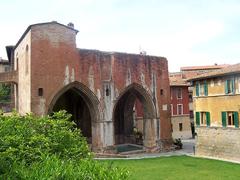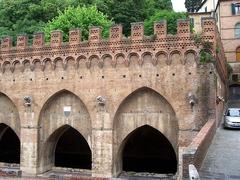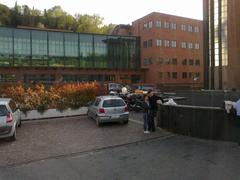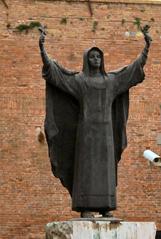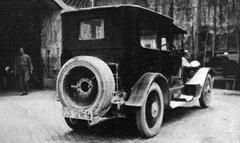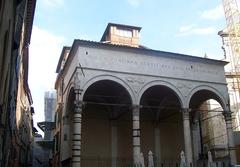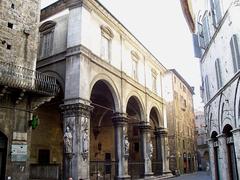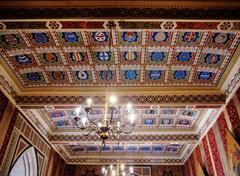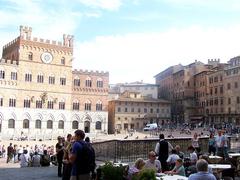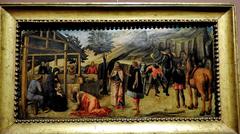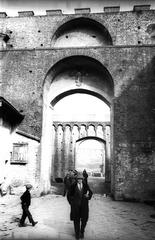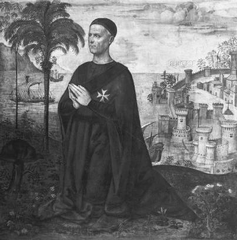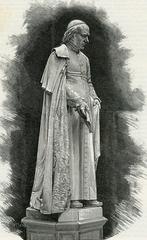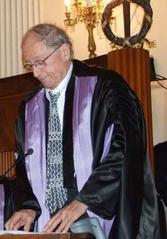
Palazzo Reale Siena: Visiting Hours, Tickets, and Historical Sites Guide
Date: 04/07/2025
Introduction: Discovering Palazzo Reale Siena
Palazzo Reale in Siena stands as a majestic testament to Tuscany’s layered history, reflecting the city’s evolution from an independent medieval republic to an important provincial capital under Medici and later Tuscan rule. Located in the heart of Siena’s UNESCO World Heritage-listed historic center, the palace offers visitors a rare opportunity to explore the political, architectural, and cultural shifts that have shaped the city. Originally constructed in the late 15th century by the influential Petrucci family, the Palazzo Reale embodies the artistic trends of the Renaissance and early Baroque eras. Today, it remains an active seat of administration, while also opening its doors during special events to those eager to uncover Siena’s storied past and its ties to iconic nearby landmarks such as Siena Cathedral and Piazza del Campo (palazzoravizza.it, Wikipedia, Google Arts & Culture).
This detailed guide offers essential visitor information—covering history, architecture, cultural context, opening hours, ticketing, and practical tips—so you can make the most of your visit to Palazzo Reale and the surrounding treasures of Siena.
Table of Contents
- Introduction
- Historical Overview
- Architectural Evolution and Artistic Highlights
- Visitor Information: Tickets, Opening Hours, and Accessibility
- Location and Nearby Attractions
- Cultural Significance
- Frequently Asked Questions (FAQ)
- Conclusion and Travel Resources
- Sources
Historical Overview
Origins and Early History
Originally known as Palazzo Petrucci, the palace was established in the second half of the 15th century by Jacopo Petrucci, a brother of Pandolfo Petrucci—one of Siena’s most powerful Renaissance-era leaders (Wikipedia). Jacopo consolidated several properties near the Siena Cathedral, creating a grand urban residence that would reflect the ambitions and influence of the Petrucci family during the city’s golden age. This period was marked by cultural vibrancy, economic prosperity, and a flourishing of the arts (palazzoravizza.it).
Transition to Medici Rule
Siena’s fortunes changed in 1555 when the city fell to Florence, ending its independence and bringing it under Medici rule (historyhit.com). The Petrucci family’s influence declined, and the palace was sold to the Medici in the late 16th century. The Medici Grand Dukes commissioned Bernardo Buontalenti, a renowned Florentine architect, to redesign and expand the building between 1590 and 1594. The renovations introduced late Renaissance and early Baroque styles, blending Sienese tradition with Florentine grandeur (palazzoravizza.it).
Role as the Seat of Government
Under Medici rule, Palazzo Reale became the official residence of the Governor of the Stato Senese, symbolizing Florentine dominance over Siena. Alongside the Fortezza Medicea, the palace reinforced the new political order and continued serving as the administrative headquarters for centuries. Today, it houses the Prefecture and provincial government offices, maintaining its relevance in civic life (palazzoravizza.it, Wikipedia).
Architectural Evolution and Artistic Highlights
Palazzo Reale’s architecture reflects Siena’s transformation from the late Middle Ages into the Renaissance and Baroque periods. The original 15th-century layout was expanded by Buontalenti, incorporating elements from the unfinished “Duomo Nuovo” project—a grand extension of the Siena Cathedral halted during the Black Death (historytools.org).
The façade is characterized by restrained Renaissance symmetry, distinguishing it from Siena’s earlier Gothic palaces. Inside, 18th-century decorative schemes include frescoes and stuccoes celebrating the power of the Medici and Lorraine dynasties. While the palace’s interiors are not generally open to the public, they may be visited during special events or guided tours (Google Arts & Culture).
Visitor Information: Tickets, Opening Hours, and Accessibility
Visiting Hours and Ticket Information
Palazzo Reale is primarily an administrative building and does not operate as a regular museum. Public access is typically granted during special events, European Heritage Days, or guided tours:
- Opening Hours: Vary according to special openings; always confirm on the Visit Siena tourism portal or the palace’s official channels before visiting.
- Tickets: Entry is usually free during special events, though some guided tours or exhibitions may require advance booking or a ticket.
- Guided Tours: Occasional tours offer expert insights into the palace’s history, architecture, and art. Spaces are limited—book early.
Accessibility
The palace is a historic structure with some accessibility limitations. Visitors with mobility impairments should contact the Soprintendenza office in advance for guidance and to arrange assistance where possible.
Visitor Tips
- Advance Booking: Essential for special tours or events due to limited capacity.
- Dress Code: Modest attire is recommended, especially during official or religious occasions.
- Photography: Flash and tripods are generally prohibited. Always observe posted rules or guidance from staff.
- Language: While Italian is the official language, English is widely spoken in tourist settings.
Location and Nearby Attractions
Palazzo Reale is located on Via del Capitano, immediately adjacent to the Siena Cathedral (Duomo di Siena). The palace is easily reached on foot from Piazza del Campo and other major sites within the car-free historic center. For those arriving by car, use public parking outside the city walls and walk or take a shuttle to the Duomo area (Travelling King).
Nearby Attractions
- Siena Cathedral: Renowned for its striped marble façade, mosaics, and works by Duccio di Buoninsegna (Visit Siena).
- Museo dell’Opera del Duomo: Home to masterpieces of Sienese art.
- Piazza del Campo: Famous for the Palio di Siena and medieval civic pride (Go Ask a Local).
- Palazzo Pubblico and Museo Civico: Features Lorenzetti’s “Allegory of Good and Bad Government” (Through Eternity).
Cultural Significance
Palazzo Reale is a powerful symbol of Siena’s resilience and adaptability. It marks the city’s transition from medieval independence to integration under the Medici and, later, the unified Kingdom of Italy. The palace’s architecture and function highlight the layers of power, identity, and artistry that define Siena (Google Arts & Culture).
Frequently Asked Questions (FAQ)
Q: What are the Palazzo Reale visiting hours?
A: The palace does not have daily public opening hours. Access is typically possible only during special events or guided tours. Check the official Visit Siena portal for updates.
Q: Are tickets required?
A: Most special openings are free, but some guided tours or exhibitions may require tickets and advance booking.
Q: Is the palace accessible for visitors with disabilities?
A: Accessibility is limited. Contact the Soprintendenza in advance for specific arrangements.
Q: Can I take photos inside?
A: Photography is often restricted, especially in sensitive areas or during official functions.
Q: What other attractions are nearby?
A: Siena Cathedral, Museo dell’Opera, Piazza del Campo, and Palazzo Pubblico are all within walking distance.
Conclusion and Travel Resources
Visiting Palazzo Reale offers a unique opportunity to delve into Siena’s post-medieval transformation and architectural heritage. While access is limited, careful planning—timing your visit with special events or tours—can provide a memorable experience beyond the city’s better-known medieval sites. Its proximity to Siena Cathedral and the vibrant Piazza del Campo makes it an essential addition to any cultural itinerary.
For up-to-date visitor information, special events, and booking details, use digital tools such as the Audiala app or the Visit Siena tourism portal. Combine your visit with other historic sites for a comprehensive understanding of Siena’s unique legacy in Tuscany.
Images
Alt text: Exterior view of the Palazzo Reale in Siena showcasing its Renaissance-Baroque façade.
Alt text: Frescoed ceilings inside Palazzo Reale illustrating Medici-era decorative cycles.
Alt text: Map highlighting the location of Palazzo Reale near Siena Cathedral and Piazza del Campo.
Sources
- Palazzo Reale (Siena), Wikipedia
- Alla scoperta dei palazzi storici di Siena, Palazzo Ravizza
- The Historic Centre of Siena: A Medieval Gem in the Heart of Tuscany, History Tools
- Historic Centre of Siena, History Hit
- The Palazzi of the Historical Families of Siena, Google Arts & Culture
- Visiting Siena Official Tourism Portal
- Ultimate Travel Guide to Siena, Travelling King
- Go Ask a Local
- Through Eternity






